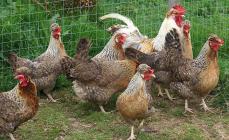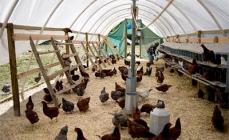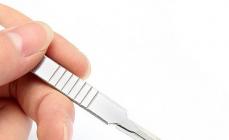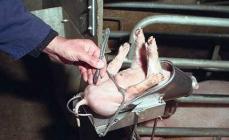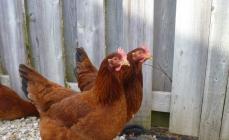Those who decide to start raising goats for meat need to know how to slaughter a goat correctly so that the meat is juicy, not saturated with blood, tasty and odorless.
Preparatory stage
It is not recommended to feed animals during the day before slaughter, but they can be given water, as water will give the meat a tender and juicy taste. A full intestine is difficult to remove from the peritoneum, and it can burst and its contents spill onto the meat. Blood doesn't drain well from such a carcass.
Before you catch an animal or bring it to a specially designated area, you need to take care of the following:
- the place where the animal will be slaughtered must be prepared in advance; for this, as a rule, a secluded corner is chosen;
- a crucifix is prepared to hang the carcass; it must be arranged so that the hind legs of the animal are spread out and firmly fixed;
- The most important thing for slaughtering any livestock, including goats, is a knife, therefore, you need to make sure in advance that it is sharp, like a blade, and that the handle does not slip and is comfortable to grip.
Is it easy to slaughter a goat?
This question is difficult to answer. If you are so attached to your pet that you doubt your abilities, then it is better to entrust this matter to professionals. If goats are raised for slaughter, then feel free to acquire skills and experience that will be useful to you later. So, everything is prepared, where to start?
Method one:
Hold the animal between your legs so that its head faces forward. Take a knife in your right hand, and with your left, lift your head by the horns or lower jaw. With a strong, firm movement of your right hand, cut the throat, and do not let go of the goat until it goes limp and the blood has stopped flowing, as shown in the video below.
Method two:
The animal is suspended with a loop over its hind leg. In a suspended state, the blood drains much faster. You can simply tie your legs and lay them on a table, snow, grass or a special machine.
After the goat is slaughtered, hang the animal on a pre-prepared device, so that the legs are spread wide so that all the blood comes out, cut off the goat's head.
To properly remove the skin, it is first cut around the hooves, then cut along the body through the groin, as shown in the video below. This must be done carefully, placing your fingers under the skin, trying not to catch the internal organs. The skin is trimmed from the tail, along the back to the head.
Some people paint the head and legs from knee to hoof, and some give it to dogs.
Only after the skin has been removed from the entire carcass do they begin to remove the entrails. You can listen to recommendations for beginners in the video.
Carcass cutting
After making an incision in the abdomen, the bladder, genitals and anus are pulled out. This procedure should be done with extreme caution, since urine, if it gets on the meat, can leave an unpleasant odor. In this case, the meat is soaked, but this is a long and not always effective procedure.
The next step will be to remove the intestines, liver and stomach. The rectum is separated from the spine by cutting the ligaments and all organs of the gastrointestinal tract are pulled out at once. Many people leave the liver in the carcass, but in any case the bile must be cut out. The heart and lungs are removed last. The liver is placed in a separate bowl.
The inside of the carcass is wiped with a clean, dry cloth to remove any remaining blood and mucus.
The principle of cutting a goat or sheep carcass is shown in the video.
The carcass is first chopped into four parts along the spine and under the ribs, and then the legs, shoulder blades, etc. are cut off.
- It is recommended to slaughter animals in the cold season, this will avoid problems with storing the meat, and the meat itself is fattier and tastier at this time.
- Before you take up the knife yourself, invite a professional for these purposes, watch how an experienced carver does it, remember, and only then do the slaughter yourself. It is difficult for an illiterate and inexperienced person to slaughter a goat himself without causing the animal painful long-term suffering and without spoiling the taste and smell of the meat.
What to do with the skin?
If the skin is left unpreserved, then after 6 hours it will begin to rot. Therefore, immediately after removal, it is spread out on a flat, clean surface sprinkled with salt, and salt is sprinkled on top. The skin absorbs salt, you can rub it with salt. After this, the skins are rolled up in a bag, with the inside facing in. The curved edges are straightened and also thoroughly rubbed. So they are stored for 4 days. During the cold season, you need to ensure that the skins do not freeze, otherwise they will burst and become unusable. To do this, they are covered with old things, or stored at a temperature not lower than 8 C.
Slaughtering animals is an unpleasant but necessary procedure for home farm owners. Every year, young goats grow up for meat, old or unhealthy goats and breeding goats are culled. The farmer needs to know how to slaughter a goat quickly, so as not to cause him suffering, and how to properly skin and cut the carcass for meat.
At what age can a goat be slaughtered?
Young animals intended for slaughter for meat are raised for several months. Most goats give birth to their offspring in early spring; by the time they go out to pasture, the young goats are actively eating grass. With the arrival of the first frost, when the cheap growing period (on pasture) comes to an end, slaughter begins.
In large dairy and meat goat breeds (Nubian, Czech, Boer), as well as their crosses, the kid is slaughtered at the age of 4–6 months. Ordinary small village varieties grow longer. The time to kill young animals for meat comes at the age of 8–10 months.
Preparations before slaughter
It is necessary to clear the room where the slaughter and cutting of the carcass will be carried out from debris. Sprinkle the floor with clean sawdust. If the animal is beaten on the street, the area must be clean and level.
It must be remembered that fresh meat instantly absorbs all foreign odors, be it manure or cleaning products. The room must be ventilated.
Before slaughtering a goat, the animal is kept on a starvation diet for at least 12 hours. This is necessary so that the digestive tract is cleared of food.
Slaughter technologies
At home, livestock are not killed with electric shock, as on large farms. A simple, quick and effective way is to cut the animal's throat with a sharp and long knife. At the same time, the artery and jugular vein are cut, the goat dies from blood loss in a matter of seconds.
To properly slaughter an animal, it is secured with ropes in a stationary position. It is important to do all preparations calmly and quickly so as not to unnecessarily irritate the goat.

What you will need
To slaughter cattle at home, you need to prepare:
- a sharp slaughtering knife with a blade length of at least 25 cm;
- a sharp knife for skinning and cutting carcasses with a blade length of 12–15 cm;
- ropes for securing the animal;
- oilcloth or a piece of thick polyethylene to lay under the carcass;
- a strong crossbar for hanging the carcass;
- blood basin;
- container for entrails;
- clean cloths to wipe your hands and knives.
All knives should be sharp and clean, with a non-slip, comfortable handle. Immediately before slaughtering a goat, a bucket of water is heated to wash hands and knives.
Step by step process
The animal is fixed in a position lying on its side or kneeling. It is more convenient to cut a small goat by simply holding it between your knees. With one hand (the left hand, if the knife is held in the right hand), the slaughterer lifts the goat’s head up, opening the throat. The second quickly and forcefully cuts the throat from left to right.
Slaughtering a large goat will require an assistant. The animal is laid on its side and all four legs are tied together. The assistant, holding the ropes, sits on the croup, preventing the cattle from moving. The slaughterer sits on the goat's shoulder or presses it with his knee and, holding the head with his hand, makes a cut in the throat.
The animal's agony continues for several seconds while blood flows out of the cut. It can be collected in a stand and used for culinary purposes.
As soon as the blood has stopped pulsating from the throat, the goat carcass is hung by the hind legs on a prepared crossbar. To do this, incisions are made in the animal's hind legs in the area of the carpal joint - between the tendon and the bone. The sharp ends of the crossbar are inserted into these cuts. The carcass should hang head down without touching the floor.
How to slaughter a goat without the meat smelling
The meat of young goats and dairy goats has no odor, which cannot be said about the male sire. The natural flavor of an adult goat can make quality meat completely unsuitable for consumption, so you need to know how to properly butcher a goat.

The male is cut in the manner described above. To prevent the meat from smelling, immediately after slaughter, the genitals of the goat are carefully cut out along with the bladder. Wash the knife and hands thoroughly with soap and water.
There are glands on the skin of a goat that secrete an odorous secretion. The skin is removed so that its hairy part does not touch the meat. After skinning, wash the knife and hands with soap and water.
How to cut up a goat carcass for meat
Hanging by the hind legs, the animal's carcass is removed from the head by continuing the throat cut around the neck and separating the vertebrae.
The skin is removed using a short knife. Around the carpal joints on the hind legs, a skin incision is made along the circumference, then the incision is made along the inner line of the thigh, carried out next to the anus (cutting off the tail - it remains on the skin) and ends on the second leg.
The skin is pulled off the carcass, helping oneself with a knife.
Gutting:
- When cutting an adult goat, the genitals and bladder are cut out first.
- Along the abdomen in the center, starting from the anus, the muscular frame is cut through to the sternum. To avoid staining the meat with intestinal contents, the end of the intestine is tightly tied with a string.
- Holding the intestine with your hand, separate all the entrails from the cavity of the carcass into a substitute basin.
Of goat tripe, liver and heart are of particular nutritional value. Kidneys, spleen, and lungs are also used for food. The intestines can be cleaned and used as casings for sausages. Unnecessary parts of the entrails are buried in the ground to a depth of at least 50–60 cm.
The condition of the internal organs can be used to judge the health of the slaughtered animal. There should be no nodules or white spots on the surface of the liver, healthy lungs should be pinkish in color, the intestines should not be swollen, and there should be no hemorrhages.
The carcass, freed from entrails, is left to lie or hang for 12 hours at a temperature of 4–6 degrees. During this time, the necessary biochemical processes occur in the meat, and it “ripens.”
Cutting goat carcass:
- along the line of the spine the carcass is cut into 2 halves;
- the hind legs are cut off in the lumbar region;
- the front legs are separated along with the shoulder blades;
- The ribs are cut lengthwise to the vertebrae, 2–4 pieces each.

Goat meat is considered a dietary and healthy product. It contains little fat and is rich in iron and other beneficial substances. Young goat meat is useful for children and the elderly, pregnant women; in terms of its performance, it is almost as good as veal.
The meat of adult goats is dark, dense, and aromatic. It is suitable for long-term stewing, making soups and cutlets.
Goats are domestic animals that are not always kept for their healthy and tasty milk. Many people breed them for wool or meat. Compliance with slaughter techniques will preserve the skin and fur covering, and will also affect the quality of future meat. Let's find out the general rules for killing goats, which are demonstrated in the video for greater clarity. In addition, we will talk about the meat productivity of these animals and about preserving the skins. So.
Meat performance
If you are interested in breeding goats for production, you need to know what qualities the product has. Beneficial properties of the product, which is popularly called “natural pharmacy”:
- Contains important amino acids that are similar to those found in beef and lamb;
- The presence of amino acids essential for the human body, such as B1, B2, etc.;
- Low fat content, which makes this product part of the diet;
- Low cholesterol;
- Goat meat is a proven preventative against diseases of the cardiovascular system;
- The absence of “sick” meat due to the fact that the goat does not suffer from most of the ailments that domestic animals have.
Due to its unique qualities, the product is recommended for consumption by the elderly, children and those on diet. Therefore, do not rush to criticize goat meat because of its specific taste. This is one of the most useful products of animal origin, which, unfortunately, has not yet reached the peak of its popularity in our kitchens.
Slaughter technique
Killing a goat is not that easy. This animal becomes a member of the family, and subtly senses the slightest changes in the owner’s mood. Therefore, it is best to ask a person who had nothing to do with caring for this animal to kill the goat.
The slaughter itself can be carried out directly in several ways. The first involves killing an animal whose head is between your legs. The goat's mouth is clamped with one hand, and the throat is cut with the other. In the second case, the animal is tied up, hung low, and the neck is pierced with a special thin knife. Some farmers kill the animal with an axe. To see the process with your own eyes, we recommend that you watch the video on our page.
Then you need to wait until the blood drains completely. After this, the carcass is fixed at a distance of 1 - 1.5 meters above the ground. I start removing the skin. It is necessary to make a special incision, which is located between the back of the head and the neck. This incision will allow you to separate the head from the body in further steps. Then, circular cuts are made in the front and rear hooves, and the entire skin is carefully removed.
A special strip is inserted between the tibia and the tendons of the hind limbs, which is considered the most convenient option for further cutting. After the skin is removed, it is necessary to remove the bladder, intestines, and liver. The esophagus must also be pulled out and the heart and lungs removed. You need to very carefully separate the gallbladder from the liver so that the meat is not bitter.
The whole procedure, with a little experience, will take no more than an hour. Then you need to start cutting up the carcass itself. To do this, you need to separate the front and back parts, and then divide them into the necessary pieces. As with slaughtering pigs, experts advise that the finished goat carcass should lie for at least 3-4 hours until it cools completely. And after that you can start cutting the meat into smaller pieces.
Preserving the skin
The carcass is cooling down. It's time to start cutting the skin. It is placed on a specially prepared clean table. Use a thin knife to remove any remaining fat from the skin. For the wet-salted method of canning, we will need ordinary table salt at the rate of 30-40% of the total mass. The skin is carefully sprinkled with salt and folded in half so that it does not dry out. So it is stored 2-3 for better impregnation. The bronze color of the product indicates that you did everything right. After a short maturation, the skin is again sprinkled with salt and rolled up in a bag. She stays in this position for 7 days. After which it is processed or sold.
Thus, with proper slaughter and cutting of a goat, the meat of the animal will become a high-quality dietary product on your table.
It has always been considered a profitable business. These unpretentious pets provide milk, meat, and skins. By combing downy breeds, a sufficient amount of valuable wool is obtained. There are varieties of meat goats. They differ from dairy cows in their rounded body and low milk yield. Goat meat is highly valued by many gourmets, and its composition is healthy. Microelements and amino acids contained in it are easily absorbed. When raising a goat, everyone is well aware of the storehouse of vitamins in its meat. But not everyone knows how to properly butcher an animal in order to obtain odorless goat meat.
Preparatory stage
 A month before slaughter, goats begin to add various concentrates to their feed, such as dirt, grain or cake. Eating them makes the meat more tender. Within a day, they stop feeding the goat and give it a lot of liquid to cleanse the intestines.
A month before slaughter, goats begin to add various concentrates to their feed, such as dirt, grain or cake. Eating them makes the meat more tender. Within a day, they stop feeding the goat and give it a lot of liquid to cleanse the intestines.
Preparing tools and a place for slaughter is also an important part of the preparatory stage. Knives need to be sharpened. There should be some long ones among them. They take several ropes of different thicknesses - for tying the legs and hanging the carcass. A thin rope is needed to tighten the esophagus. A place is being organized where the animal will be hung; it’s a good idea to have hooks like in professional slaughterhouses.
Basic process of slaughter and butchering
After the preparatory activities, the goat is rolled onto its side; its legs need to be tied well. It is advisable to carry out these actions together. While they hold the head with one hand, they feel the cartilage on the throat with the other. A little below this cartilage, the larynx, carotid artery and blood tubes are cut with a sharp movement. Blood is collected in a separate container. The carcass is hung up and the skin begins to be removed from the bloodless mass. For clarity, you can watch a video of cutting up a pet.
The skinning process is carried out in sequential steps. Start with the front legs and neck. Making cuts:
- around the hind legs and transversely between them through the anus;
- from the joint of one foreleg through the chest to a similar place of the other forelimb;
- starting from the throat, through the stomach to the tail, a longitudinal incision is made.
The skin is removed in a layer. Gently pulls away from the body. You can lightly help with a knife in areas of strong ligaments. It is important not to damage the fur and not leave fat and meat on the skin. As you can see in the video, this is a whole art.
After removing the skin, it is necessary to bandage the esophageal canal. Then cut off the legs. The hind limbs are cut at the hock joint. The front legs are cut at the carpal joint. After first cutting through the muscles, the anus is removed. After an incision in the abdominal wall, the rectum is carefully disconnected by cutting the ligaments. Next, the stomach moves to the side, the esophageal canal stretches, and the intestinal ligaments break. Finally, the entrails can be removed from the belly. They are placed in a previously prepared clean container.
The goat carcass should be thoroughly wiped and free of any remaining blood. Next, under the ribs, the torso is divided into front and back parts (as in the video below). Depending on further use, the rib pieces can also be chopped. What remains is the spine and hind legs. After cutting off the backbone, the goat's limbs can be left intact. If necessary, they are divided into parts.
That's all. The process is over. By following the correct sequence of actions, you will get excellent healthy goat meat, and then it’s up to the hostess’s imagination.
